THE MEMOIR OF A BEEF BURGER
MY grandfather was a mysterious man.
Not much is known for facts but there are certainly many stories about him, speaking of a skinny, humble working-class man often seen in between two slices of bread trying to make a buck or two at food fairs back in the late 1800’s. Who his ancestors were and where they came from, is still up to this day, my most intimate wonders. Were they even named a Burger? And whatever stories, legends even, being told about his tale of becoming the untoppled icon of a nation’s food-identity, remain exactly that, just stories. But if there is one thing indisputable about those stories, the truth that inspired the myth, or at least so everyone says, it’s that he was a fine and proud citizen of America. And that’s fine enough by me.
Truth is, I was never too held up on who my grandfather was. After all, I’m pretty sure, I am nothing like him. I am more of the making of my father, who’s the heir of an idea and the product of the industrial revolution, who, all together, turned what my grandfather left him into an empire that forever changed how a country eats, the world even, for better or worse. In various steps and establishments, he invented a new era in America called the fast food around the 1940’s, who defined and made our family name, Hamburger, known to literally every man, woman, child, some lucky dogs and city pigeons around this world. Most adore him. Many don’t. History will decide wether to side with him or not, but one thing for sure is that he is a great, historic man, and I am, his legacy.
MY FATHER IS A GREAT, HISTORIC MAN. AND I AM, HIS LEGACY
My father is a man of few words… for that I don’t know what aspirations, if any, he has for me. Yes, has. I didn’t say he dead. In fact, he is at the height of his prime at expanding his already mega dollar-making machine through every human-occupied corners of this world. Right, loaded. That we are, too. Perhaps it’s precisely because I grew up accustomed to the security and comfort of a family establishment, I became something you would call, a rebel. I have no desire to follow my father’s footsteps in the advancement towards industrial fooding. It’s a fortune yes, but nonetheless a fortune made on basic, unornamented commodities that lack glam and artistry. Like the rest of my own kind, the third generation of a traditional empire who has too much to prove for themselves, I am, above all else, eager to redefine.
And boy, redefined I have.
Somewhere in the last decade was the ignition of my own torch to pass down, and it’s burning brighter than ever. My grandfather would never in his wildest dreams, the flappy white toasts and leftover ground meat that he was, imagined the burger that I am today. A long way from being a mere necessity in the 1800’s, or the cold counters of soulless assembly-lines in the 1900’s, I am the poster child of the modern American food-scene, attended with almost obsessive care, even labeled black, served to the most stellar eaters in the country. I carry myself with prestigious cuts of beef, in the company of top knives in the industry. I am more than food. I am porn. Some even say, better than sex. I wouldn’t know. I’m just a burger.
But that was the hubris of my youth. Today, I am an older, wiser man. In the settlement of fireworks and egos, I have grown enough confidence to tell you that mastering me is only as difficult as the industry would like you to believe. With simple tips and tricks, I am not, unlike my grandfather, a mystery.
And maybe, who knows, that you’ll be the next human to reshape the future of my family.
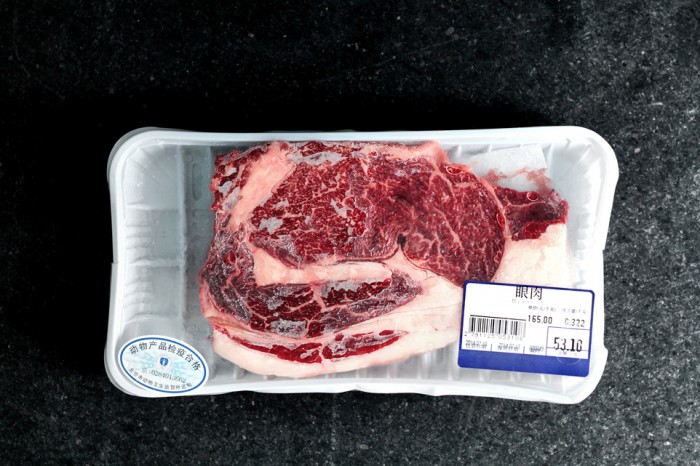
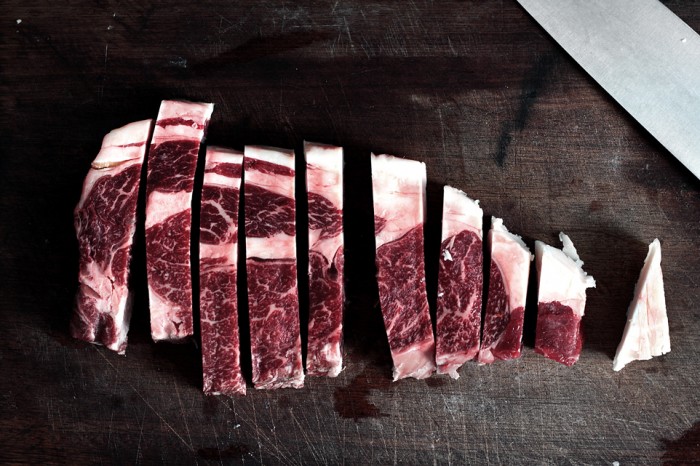
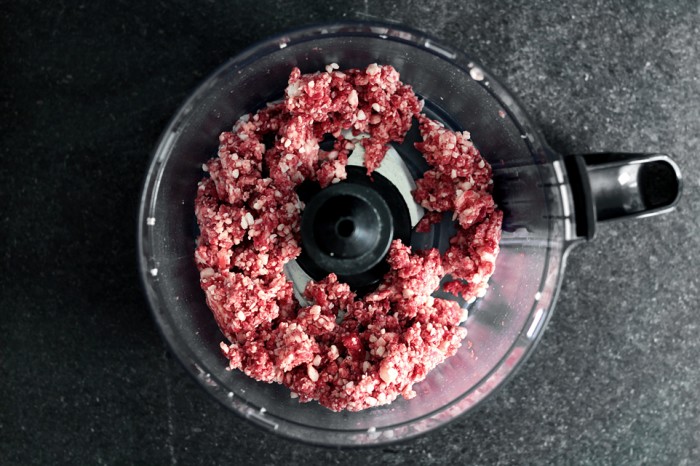

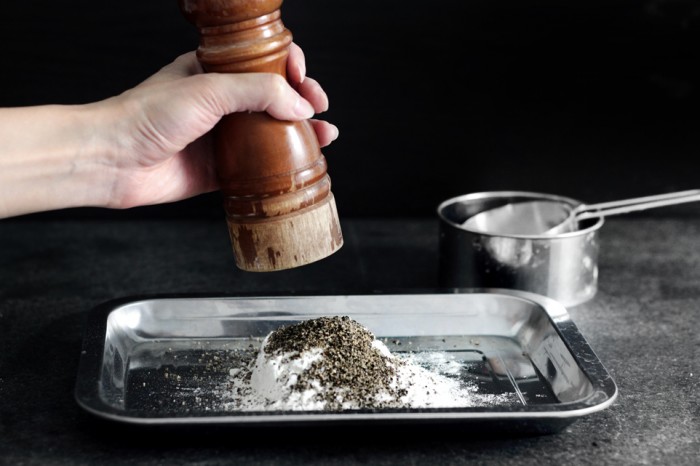
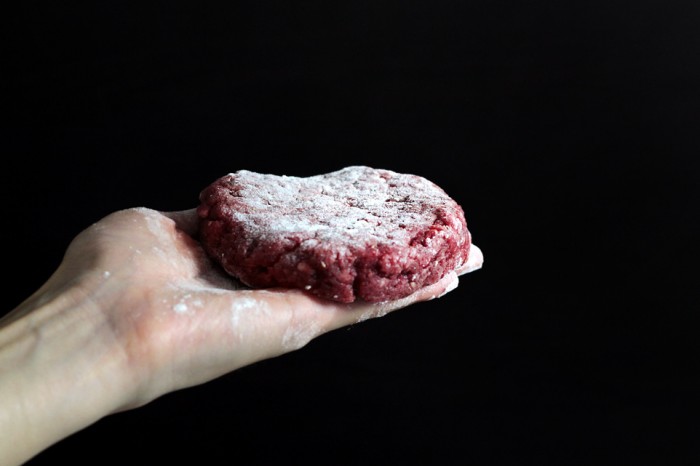
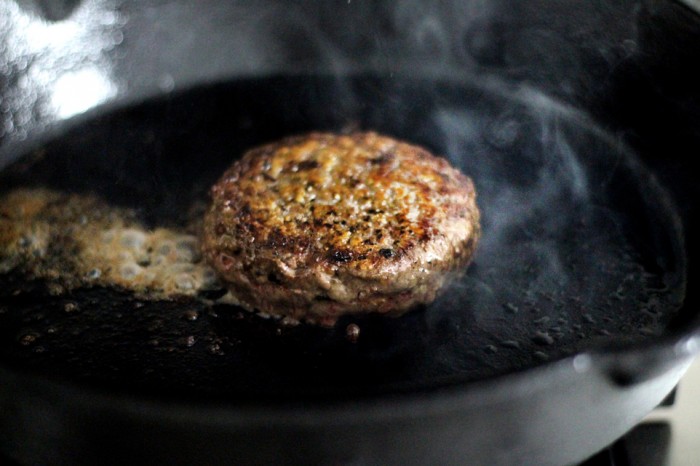
To home-grind your patty, or not to home-grind your patty? Well, there are pros and cons on both sides.
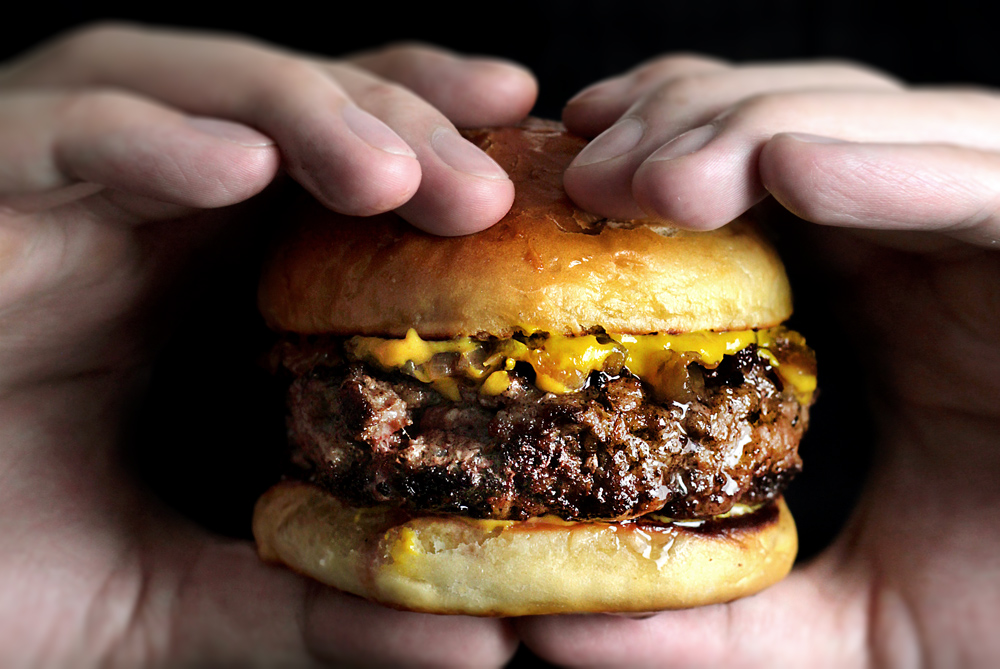
- PROS on grinding your own beef:
- You get to be as fancy as you’d like with the cuts. A combination of aged rib-eye, skirt steak and brisket is said to be the blend of supremacy. The secret on the ratio is a highly guarded, overrated marketing gimmick in my opinion. You pretty much can’t go wrong with these cuts, as long as you don’t included unwanted tendons and excess connective tissues. Whatever the combination is, I like to result on a total 30% of fat just because we are on the subject of lusciousness
- Update on 2014/07/13: A reader reminded me that adding seasoning and spices directly into the ground meat (like making sausages) is also another pros! Because mixing already-ground beef can make the meat tough.
- CONS on grinding your own beef:
- Most people will default to a food-processor for grinding at home. But if your food-processor is a less robust machinery, it can result in uneven, chewy bits of fat and connective tissues that aren’t cut properly. Running the machine for too long will give you a pasty, woody ground which is no better than store-bought ground beef, not to mention a waste of money.
- The consistency of a food-processor ground beef is still, more or less, different than from a meat grinder. The meats are cut into tiny tiny pieces that resembles ground meat, but has a “chunkier” texture. Some prefer it. Some don’t. For example, you can compare the difference in texture between the top-left picture (food-processor ground) with the top-right picture (store-bought meat grinder).
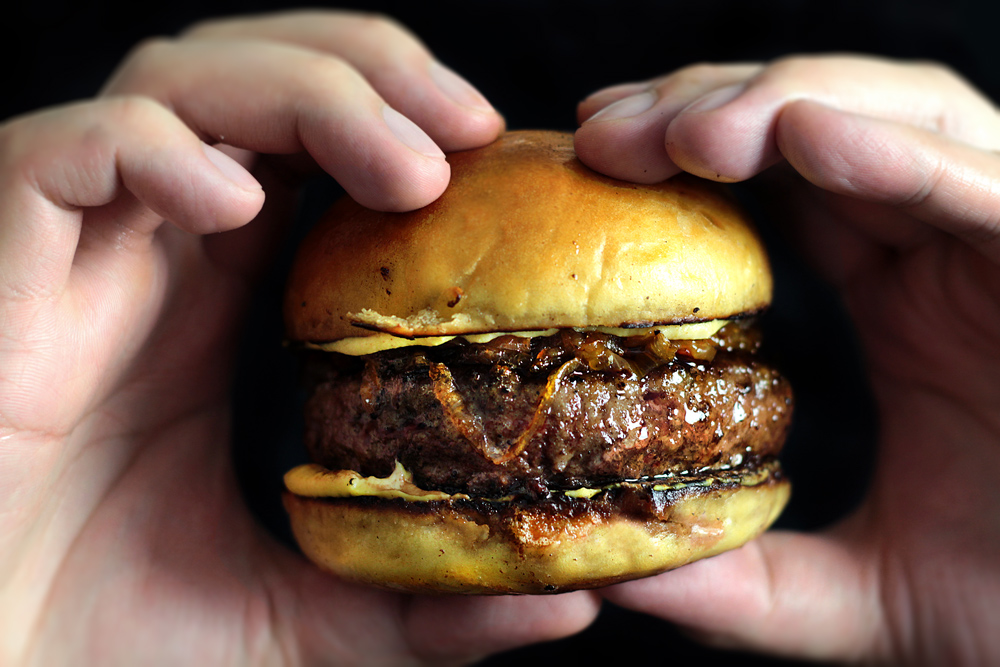
- PROS on store-bought ground beef:
- Well, convenience. And cheap.
- CONS on store-bought ground beef:
- Most of supermarket’s ground beef is run through a fine-grind setting, resulting in a bit of “mushy” texture. It is better to ask the butcher, if you have one, to grind the beef on demand through a coarse setting on the meat-grinder.
- Obviously you’ll have less control over the fat-content and cuts of the beef. The fat content will affect how much the patty will shrink during cooking (more details on shaping the patty in the recipe). Some supermarkets do label the fat-contents of the meat, some don’t. But is this going to present a huge problem for you? Not really. The shortcomings of store-bought ground beef can be made up with some flavouring tricks that will turn it into a great burger as well.
Whether or not your patty is of a fancy cuts of beef or down-to-earth store-bought, it should be treated with the same care and details.
There’s a few things here that is a bit unorthodox. First, is stuffing butter inside the patty. This recipe is one of the rare cases where you want o use salted butter, instead of unsalted butter. The salted-ness will flavour the center of the patty where you otherwise can’t (mixing the ground beef in order to season it, will toughen the meat). The butter will melt and run through the ground meat during cooking. Even though you may loose most of the butter, the result is a more flavourful and juicier patty. Update 2014/07/13: Using herbed/seasoned butter can be a good way to introduce added flavour to store-bought ground beef without having to mix it. A reader suggested using frozen butter to prevent melting too fast during cooking. Let me know if anybody has tested this theory :)
Then, the dusting of seasoned flour on both sides of the patty can seem quite weird. But I think it encourages caramelizing and the forming of a “crust”. Just a whiff-y thin layer of seasoned flour will not taste like “breading”, but instead, a deeper… nuttier and crustier surface.
Then, I like toasting the buns in the same skillet as the patty is cooking. They will pick up the rendered fat and browned bits. Overall, more flavourful.
This burger is kept simple, just a great patty, great bun, caramelized onion and Dijon mustard. I’m not including any measurements/weights for patty because it will vary greatly based on the size of the buns using. You should measure the patty based on diameter and thickness. And I’m using these potato rolls. I’m not going to include instruction for caramelized onion because it’s already widely available. But adding a few halved cherry tomatoes while cooking the onions (let them caramelize together) will add good flavour.
To grind your own beef: Choose a combination of cuts between rib-eye (for fat and flavour), skirt steak, chuck or brisket (for beefy flavour) with the total ratio of fat at about 30% (I used only rib-eye). Remove a small piece of fat from the steak and reserve for cooking, then cut the rest into small chunks. Cover with plastic-wrap and flash-freeze for 1 ~ 1:30 hours until hardened (but not stone-hard). Transfer them into the food-processor, filling it only 1/3 of the way at a time, and pulse until the meats are cut/ground into very tiny pieces, resembling ground meat. If not using immediately, transfer the ground beef onto a paper towel-lined baking sheet (to absorb excess liquid) and keep cold inside the fridge.
At 30% fat, the patty will shrink during cooking as fats are rendered down. So you need to calculate the diameter of the patty at 15% larger than the diameter of the buns, and each patty should be 3/4″ thick (about 2 cm). I highly recommend using a round biscuit-cutter to help forming uniformly shaped patties! It makes a difference.
Choose a round cutter with the right diameter for your patty. Put a layer of ground beef down and make sure it conforms tightly to the shape of the cutter. In the center of the patty, put a slice of salted butter that’s about 1 tsp, then top with another layer of ground beef. The whole patty should be 3/4″ thick. Again, make sure that the meat conforms tightly to the cutter, as well as sticking soundly to the bottom layer of meat. Slowly remove the cutter/mold, then transfer the patty to a paper towel-lined baking sheet. Repeat with the rest.
To use store-bought ground beef: Store-bought ground beef usually ranges from 10% to 20% fat, sometimes up to 25%. The leaner the beef, the less it will shrink during cooking, so pick a round cutter/mold that’s 5% larger than the buns. Repeat the making of patties as instructed above.
To cook the patty: Mix 1/2 cup (63 grams) of flour with 1 tsp of salt and 2 tsp of freshly ground black pepper. Lightly pat both sides of a patty with the flour mixture, and dust off ANY excess. Heat a large, heavy-bottomed skillet over high heat. Rub the reserved beef-fat on the surface of the skillet until you have a thin layer of oil (or use bacon-dripping). Gently place the patty on the skillet, and toast the cut-side of the buns on the side. Don’t move the patty until you see a browned crust has formed on the bottom of the patty, then flip it over (the interior butter will ooze out, it’s ok)(remember to remove the buns once they are toasted!). Re-seaon the patty with sea salt and freshly ground black pepper during cooking. Never cook the patty all the way through. The best doneness, I think, is medium-well done. The patty should have deeply caramelized crust on both sides, but you’ll still see pinkish juice oozing out from the mid-section. The skillet needs to be hot enough to achieve this.
Transfer the patty over to the bun that’s already smeared with Dijon mustard on both sides. Top with caramelized onions and let rest for 5 min, then serve.
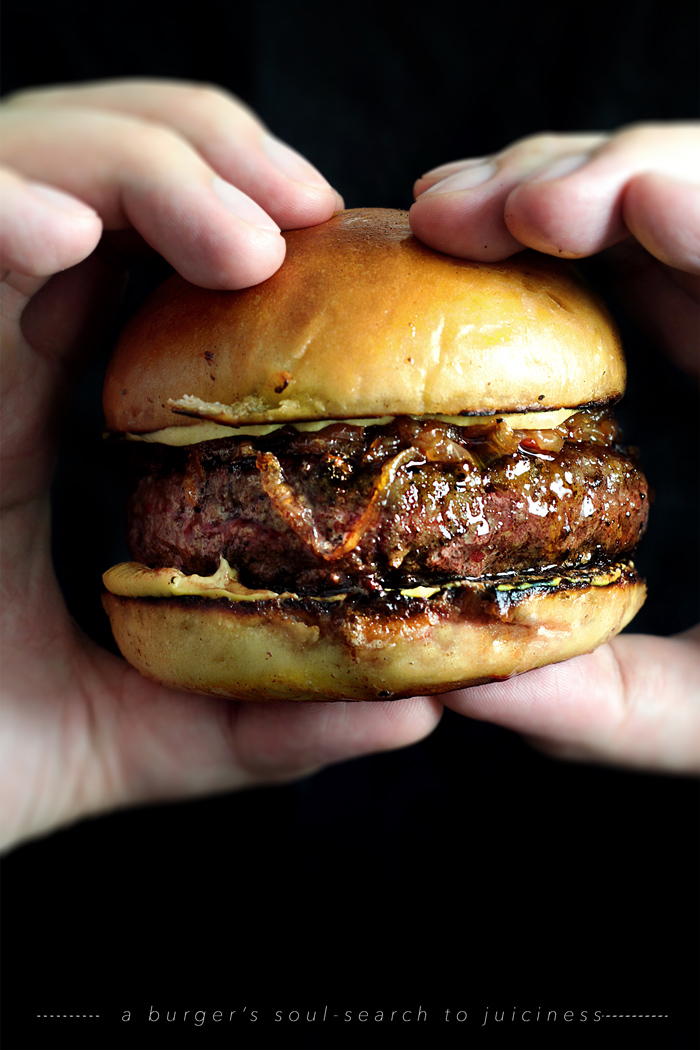


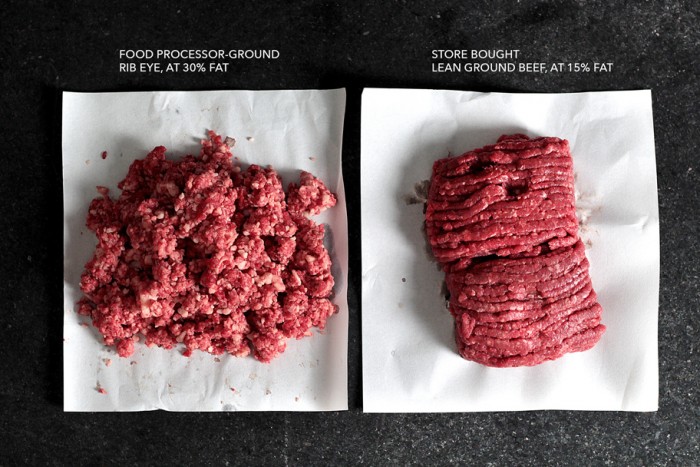
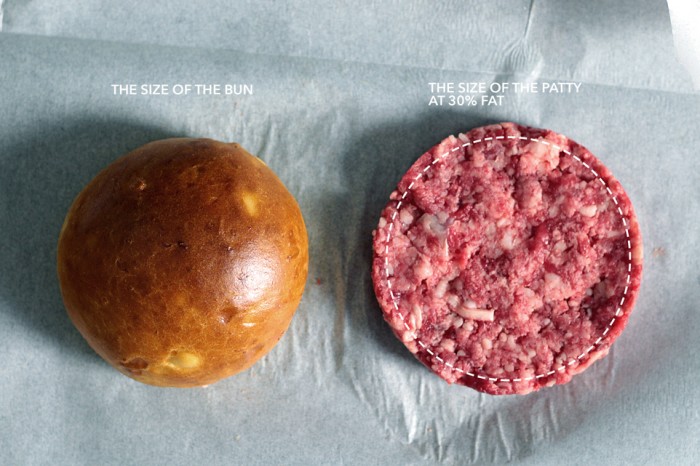
sue/the view from great island
07.12.2014at2:14 AMThis post makes me proud to be a food blogger…
Abbe@This is How I Cook
07.12.2014at3:27 AMIf I still ate burgers, I would be drooling by now. Well, I am drooling right now. And if I still ate burgers, I would cook them just like you do. Because that is what I did when I ate burgers. You are killing me here!
Michelle @ Healthy Recipe Ecstasy
07.12.2014at5:19 AMYour writing entrances me. So does your burger.
Steph
07.12.2014at6:54 AMI LOVED the burger story :D
kate
07.12.2014at10:29 AMfor a moment i thought you were part of the family that started the burger/fast food!!your writing is spectacular
Adrian @ The Food Gays
07.12.2014at10:56 AMlovely post. writing from the perspective of the burger just seemed natural.
Roodelia
07.12.2014at12:33 PMBeautiful blog, awesome post! I’m glad I stumbled upon this from The Vanilla Bean Blog. It’s heartening to see more food bloggers writing with flair!
sue
07.12.2014at9:30 PMUnbelievable post, recipe, story, photos. Wow! I need to brush up on my math before I start this recipe! I have been grinding my own beef for years and it makes such a difference. I have never added butter, but I cook in a cast iron skillet in bacon grease. I can’t wait to try your version!!
Millie l Add A Little
07.13.2014at3:03 AMThis looks so frickin good Mandy. And you make me actually want to grind my own meat because your patty looks seriously top quality awesomeness!!
http://youtube.com/addalittlefood
Crystal | Apples & Sparkle
07.13.2014at5:10 PMGreat post! Amazing recipe as always!
David
07.13.2014at5:14 PMIf there is one food that ignites my passion for food, it is hamburgers. The following is my opinion. I recognize they may not be shared by everyone. They are my opinions alone. // Two years ago I bought a meat grinder. A real meat grinder. A 2 horsepower beast. Before the acquisition of said meat grinder I used the same method you used, the one Cook’s Illustrated penned, via KL-A. But I needed something that I could play with. Since that purchase I have never purchased ground meat again. I once cooked a burger that was, by my estimates 90 percent fat. Short ribs, beef bone marrow, ox tail, and deckle. The patty was white with red flecks of protein. I have experimented at perfecting my perfect burger. I like 50:50; short rib:chuck. Ground once, coarsely. Pile it up in a bowl, left in the refrigerator for 30 minutes. Scooped with large disher. Placed directly on a medium-high cast iron skillet. Seasoned. Thinly sliced onions placed on top. Smashed thin. Fried for 2 minutes. Flipped. Fried for 90 seconds. Toasted buns. Homemade Russian Dressing: kewpie mayo, catsup, dijon mustard, pickle relish, tabasco, apple cider vinegar, onion powder, salt and pepper. Butter lettuce (to make it health food). Done. I have also experimented with regional, American-styles of burger cookery. Onion burger, butter burger, slider, mini burger, chili burger, Jucy Lucy, Maid-rite, cheese skirt, green chili, etc., etc… Needless to say I am a burger enthusiast. A few thoughts I had while reading your article, Mandy: I would use caution with using a ring mold, since you can easily over pack the patties and lose the nice texture you get by grinding your own beef (due to heat from your fingers and pressure from packing). If you must flour your patties, I would recommend Wondra (brand) flour. It is milled extra fine and is used extensively on fish skins to achieve extra crispiness without adding flavor. I would contend that if your pan is heated correctly, added browning agents is unnecessary. The butter idea is something I haven’t seen before, kudos. Wisconsin has their butter burgers, but that is simply adding a pat of burger to the cooking burger, then another pat of butter to the bun (sometimes using as much as 1/2 cup of butter!!!). I would be hesitant to use salted butter though because it will change the patty’s texture while cooking, resulting in a sausage like texture, rather than crumbly; see sausage science for explanation, TL;DR proteins untangle, then re-tangle). Properly seasoning the outside of the burger should be more than enough. All this being said, I can say that with out a doubt I would still happily eat your burger and find it delicious. I have spent hundreds of hours reading about all things burger. They are one of my great passions. In the end, I think taste is subjective. What I expressed in this comment are my opinions. I’ll leave cheese additions for later.
mandy@ladyandpups
07.13.2014at10:50 PMDAVID: I LOVE your super constructive comment!! thanks! 90% fat burger? That’s criminally brilliant… I MUST TRY the bone-marrow mix you got there next time! That will be a great recipe for thinner patties!!
I’ve never used a meat-grinder and I agree that the texture of a grinder-meat and food processor-meat is slightly different. The ring mold is, I agree, sort of a dispute. With food-processor ground beef which is chunkier than usual, the ring-mold doesn’t affect the texture as much. But with mushy store-bought ground beef, too much packing definitely can affect the texture. I guess I could be a little anal about how perfectly the patty fits the bun (one of my burger OCD) even though it doesn’t affect the overall taste.
From this particular experiment, the salted butter didn’t change the texture of the meat too much. I cooked the patty immediately after I made it, so the meat had very little time to be in tact with the salt to react. Even though I did loose some of the butter during cooking, I thought it made a particularly juicy patty. Then again, this idea wouldn’t work with thin patty of course because there’s no room for it.
Irene @ {a swoonful of sugar}
07.14.2014at7:46 AMMandy, those are some ridiculously incredible burger shots… Thanks again for such an informative post. The butter in patty technique sounds genius, especially herbed butter oh my goodness and your potato rolls are the perfect vessel for these patties.
Bri | Bites of Bri
07.14.2014at8:31 PMI loved reading this. The writing and photos were spectacular and I now know how I must have my next burger! My only remaining question is this: what do you think about the KA meat grinder attachment? Sure it falls short compared to David’s meat grinder but is it better than a food processor?
mandy@ladyandpups
07.14.2014at9:06 PMBri, I’ve owned and used kitchen aid meat grinder attachment to the stand mixer before, but I felt like it wasn’t the easiest thing to use. The grinder gets congested easily and gets stuck. Maybe it’s just me, but I thought food processor, in this case, probably worked better…
Quyen
07.15.2014at12:22 AMVery cool. I will definitely try grinding my own burgers from now on. Thanks for the inspiration!
Nicky @ Kitchen Sanctuary
07.15.2014at5:50 AMDrool…. that looks so yummy. Amazing photos too!
Thalia @ butter and brioche
07.15.2014at1:40 PMawesome post.. picked up some new ideas and information. growing up in a vegetarian household, i need all the help i can get when it comes to understanding meat. thanks for sharing!
Jer
07.31.2014at6:23 AMSo, I may be committing a burger sin, but I love putting chopped sweet onion, a nice dashing of sea salt and a bit of cracked black pepper into the ground beef, and then make the patties, large and fat. Flame broil them on the grill in the backyard. They come out so just right because of the moisture being given off by the onion cooking in the burger, which then helps to saturate the onion taste a bit more into the meat. Very yum. Thanks for your postings, they provide lots of inspiration and longings.
Maureena
09.03.2014at4:06 AMYesterday for the first time I ground meat (from a 7-bone chuck roast) at home to make burgers. I was amazed at the loose, crumbly texture of the ground meat. Mixing the seasonings in was so easy. I formed the patties gently and grilled them over charcoal. These burgers were A REVELATION. I used a very cheap and rather crappy grinder, and I might get the KA mixer grinder someday soon. I’m not quite ready to get into the kind of meat grinding horsepower David has, but I recommend comparing the food processor ground meat (which is much better than store-ground, I’m sure) to ground meat from a grinder. Those burgers I made almost brought tears to my eyes, they were so good.
Keoni
08.11.2015at9:47 AMWill using a meat grinder kitchen aid attachment suffice and yield same results?
mandy@ladyandpups
08.11.2015at1:40 PMKeoni, I’ve never used one of those before so I cant say. But I can’t imagine why not :)